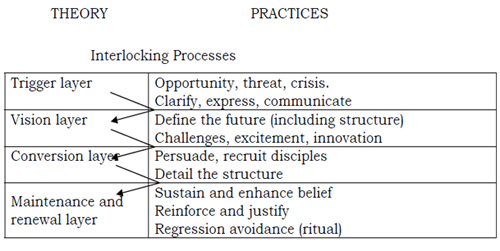Creating Sustainable Change – How to create and sustain change?
April 3, 2025
 Creating Sustainable Change – How to create and sustain change?
Creating Sustainable Change – How to create and sustain change?
Who doesn’t like change and who doesn’t want to change? These are certainly truisms in the 21st century landscape where businesses proclaim their commitment to change and exhort their employees to “Be the change you want to see”. However, having a vision and mission statement that commits to change is different from actualizing the change.…
 Why Some Organizations are Better at Driving Change ?
Why Some Organizations are Better at Driving Change ?
We live in a world where increasing complexity is the order of the day and the business landscape is characterized by a rapid turnover of companies which find themselves dethroned from their position because of outmoded thinking or anachronistic strategies. For instance, Nokia and RIM (the maker of Blackberry) were at the top of the…
 Contingency Model of Change Management: Dunphy and Stace’s Model of Change
Contingency Model of Change Management: Dunphy and Stace’s Model of Change
The contingency model is an extended version of Lewin’s three step in which Dunphy and Stace (1988, 1992 and 1993), explained the process of change from the transformational organization perspective. Dunphy and Stace (1993), put forth a situational or contingency model of change, which emphasized on the fact that organizations should vary their change strategies…
The process of Transition Management involves the implementation of change through systematic planning, organizing and implementation of change to reach the desirable future state without affecting the continuity of business during the process of change.
The process of transition management begins much before the actual change occurs and the members of the senior management play the role of transition managers who support the change agent in the overall process of change.
During the entire process of transition, effective communication with all the key stakeholders directly or indirectly involved in the process plays a vital role.
Buchanan Mc Calman (1989) proposed a framework on ‘Perpetual Transition Management’, which provides crucial insights regarding what triggers organizational change and also the response of the organizations towards the change.
The model proposes four key layers and the interlocking management processes which bring change in an organization. These are:

Source: Buchanan, O.A., Mc Calman, J, High-Performance Work System: The Digital Experience, Rouderedge, London (1989).
The above model implies that for any change to be successful, effective planning, resources management, communication of the outcomes of change and a large-scale involvement of the management will be required in connection with the four interlocking processes or layers.
While analyzing the Trigger Layer, it is important to understand what is actually creating the need for change. It must involve clear expression and communication of the objectives of change across all the levels in an organization.
In the absence of effective communication and due to poor trigger identification, people usually tend to misunderstand or develop bias towards the change and try to keep away from the process due to a perceived fear of failure.
Hence, both acceptance of change by understanding its nuances correctly and acknowledgement of the need for change actually play a crucial role in the entire process.
The manner in which these triggers are communicated and expressed clearly so that everyone develops a shared understanding of the opportunities, threats, risks, etc, will ultimately define the success of change in an organization.
Just like shared understanding and identification of the triggers of change help in ensuring seamless process transition, description and understanding of the vision of the organization equally, play a crucial role in determining the success of the overall process.
The management must consider three criterions for deciding regarding the vision or future.
The third Layer of conversion involves recruiting disciples and establishing the structures or needed systems and processes in place. This process may be time-consuming as it is detailed in its approach and the members involved in the process of change need to own the entire process.
The managers firstly form a Planning team who are responsible for the overall process of change and secondly pay a lot of importance to the talking to people about the change in formal and informal setups in every given opportunity.
The last layer Maintenance and Renewal attempt to resolve the issues related to decay in connection with the management during a mid-term change.
The Three Components of Transition as per Ogilvie
Ending (3 D’s): This stage may be extremely painful, and it may involve multiple reactions:
Transition (3 D’s): Before accepting the new methods or practices, people usually face the stages of transition which may involve the following reactions:
Beginning (3 I’s): This is the stage of Recovering and starting once again
Your email address will not be published. Required fields are marked *